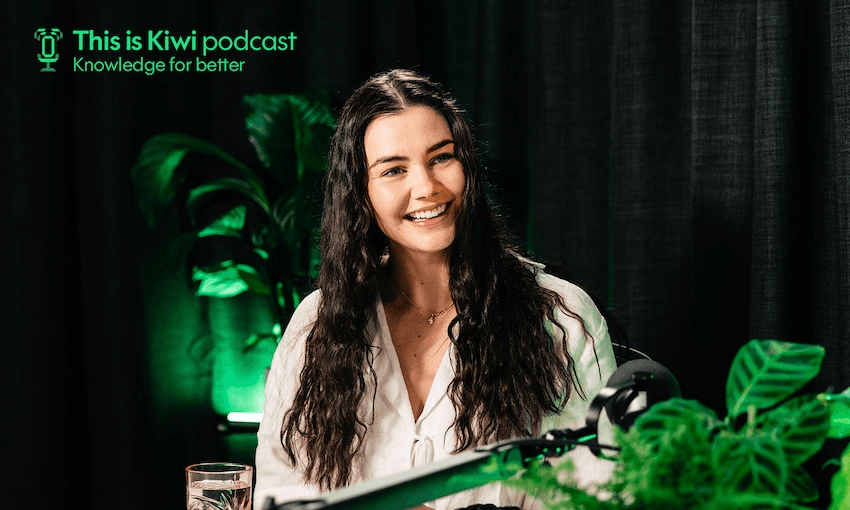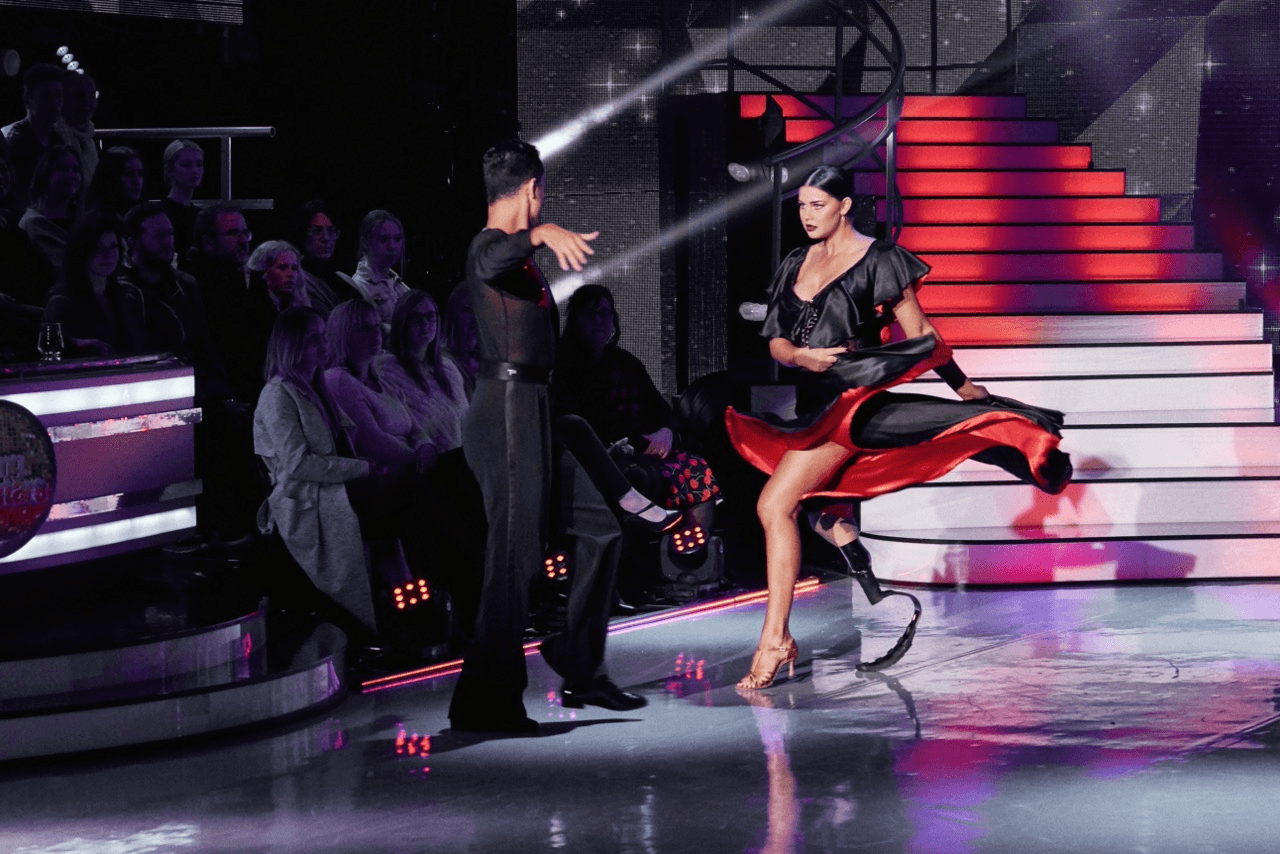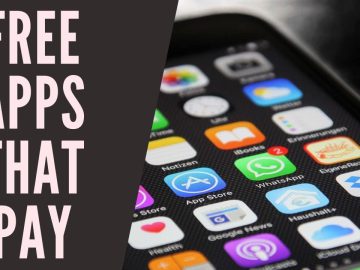As a teen she cried herself to sleep every night – now she’s a successful entrepreneur, author, model and influencer. Jess Quinn joined Kiwibank’s This is Kiwi podcast to talk about the myth of a ‘normal’ body and why she’s a firm believer in faking it till you make it.
Life changed in the blink of an eye for Jess Quinn. She was an active kid, who loved animals and being outside. Her dream was to be a vet, an athlete. To hear Quinn tell it, her early years were incredible. Most of her time was spent with her two sisters, her forever best friends.
While playing outside one afternoon, Quinn stood on a soccer ball. “I was showing off to my sister, and I fell to the ground, my femur had snapped in half, it’s supposed to be the strongest bone in your body.” Quinn was rushed into emergency surgery to repair the break. After pins, rods, intense plasters and painful rehab, Quinn’s leg just wouldn’t heal. A series of tests revealed she had osteosarcoma, an aggressive bone cancer. Quinn was rushed in again for immediate chemotherapy.
From there Quinn went from being “so-called normal and very happy, to existing in a world (she) didn’t even know existed”. She was just eight years old. Fast forward to 2024, though, and Quinn is an entrepreneur, advocate, author, model and mum. Generic budgeting tips don’t work for her ambition or her abilities and she’s found a way to make life and work work for her. Quinn joined Jane Yee on This is Kiwi, a Kiwibank series in collaboration with The Spinoff Podcast Network. Read an excerpt from the full interview below.
Photo: Supplied
So suddenly your life took such a dramatic turn. Talk us through what happened.
So I had chemo for nine months. I saw things that no eight-year-old should ever have to see. I’d have friends in the playroom at the hospital one day, and then they weren’t there the next because they’d passed away. I went from being a really healthy kid to weighing 18kg. I had quite a few times where I nearly lost my life.
What happened next?
My cancer just wasn’t going away so they decided to amputate my leg. Usually you’d get a below or above the knee amputation but because of the surgery that I’d had, there was a risk the pins would push the cancer higher into my body. They did what’s called a rotation plasti, which is where they cut high into the hip and then below the knee and get rid of that area, because that’s where the cancer was. Then they rotated the bottom half of my leg 180 degrees, and attached that to my hip. So my foot acts like a knee, if you like. My heel is my knee. It took about 14 hours to do that procedure.
You’ve done so much now to support others with disabilities. How did you get there?
I often would be in a room for checkups and there would be 10 surgeons in the room, because my case was so unique, something that they hadn’t seen. Through that I got really used to telling my story. But yeah, I had to go through a lot of growing up and a lot of healing and grief, and come to terms with what I’d been through, before I could share that story.
What’s been the hardest part of that journey?
My teenage years were by far the hardest. I spent probably close to two years crying myself to sleep every night, and I remember repeating the words, Why me? Why me? But you know, cancer nearly took my life away from me. At some point I realised that I just needed to kind of fake it till I made it. I thought maybe if I just pretend that I’m confident in my skin, then maybe one day it will stick, and one day I realised that it had stuck, and I did feel confident in my skin.
Do you think the word ‘normal’ can be quite a damaging term? I love how you referred to it as ‘so-called normal’.
I don’t think there is one normal. There is common though, and I think there is a common way to have a body, and I didn’t live in one of those, or I don’t live in one of those any more. Like, I’m not going to pretend that my body is so-called normal or common, because I know that it’s not. But why does that have to be a bad thing?
What led you into this trajectory to go from explaining your situation again and again in a room full of trainee doctors to actually spreading that out wider to the world?
It happened accidentally. I found exercise. The gym was a place where I could compete with myself. I got a running blade. I started to become really comfortable in who I was. And then I did a photo shoot, because I got a running blade with a friend who was a photographer. I ended up posting the photo to my very small audience on Instagram. A few days later it went viral, which was the strangest experience of my life.
So what happens after this photo goes viral?
The next day, I woke up with 10,000 followers, and within a month or so, I had about 70,000 followers, and I kept sharing photos from that shoot, because there were so many cool photos, and I loved them. I kept getting messages from people saying how they really resonated with my story. And it just kept growing from there.
Photo: supplied
So you went viral accidentally and there was an opportunity there. Social media is a very tense place to exist. What’s it like being so visible there?
It’s an interesting place. A lot of it is figuring out what I’m comfortable sharing, what I’m not comfortable sharing. I used to just share my blade. Now I’ll show me crawling around on the floor, how I get around without my leg on. I will show my backwards foot. When I was pregnant, I thought it was insane that I was growing a human and doing so with a backwards foot, and I just thought the whole look of my body was just amazing. I shared that. My confidence has grown with my audience.
You’ve spoken out before about taking the importance of digital detox and taking time away from social media and that kind of thing. So talk me through the mindset behind that.
Three and a half years into this social media game, I burnt out really bad. I’m constantly thinking about what I’m going to share – and also my life is my job. So there’s kind of no line there. And so I learned to set some boundaries. Nine times out of 10, I don’t post on the weekend. I clock off on a Friday, and I clock back on a Monday. Sometimes I delete the app on a Friday.
Photo: Supplied
What was Dancing With The Stars like for you?
It was huge for me. On many levels, obviously, it’s a huge opportunity, it’s amazing, but on a personal level, it was a huge honour. From a confidence perspective, to look back on younger Jess and say “You wore lycra on live TV!” That is insane.
Your beautiful baby Marla is six months old. What has navigating baby life been like for you?
We had a long fertility journey. There were times when we were consciously trying for a baby. I said to my partner, I was like, should we be doing this? Like, I don’t know if I am capable enough for this. I knew I could figure it out, but this is going to impact my life so much. I already have to think every second of every day how to put one foot in front of the other. But once I throw a baby in the mix… I’m capable, but it does take a massive toll on my body.
If you could sum up your success up to now in one word, what would it be?
Resilience. I’m confident that I can get through almost anything. It doesn’t mean that I don’t question whether I can or that I nail it every time, but I am very confident in my mindset.
So what’s your relationship with money like?
I am fascinated by money conversations. It’s something I’m passionate about. I have a very expensive life. Not because I buy crazy bougie things. I have an expensive life because I have a chronic health condition and a disability. And as much as I do get some support, I don’t get a huge amount of support. I would love to be in a situation where money isn’t impacting my abilities, my pain levels or my condition. So yeah money has always been front of my mind because of that.
What’s a time money unlocked something for you?
After Dancing With The Stars my foot started swelling. It wasn’t directly caused by Dancing With The Stars but it was the straw that broke the camel’s back. I couldn’t put my leg on. So I couldn’t walk for two years. I saw every expert in New Zealand. No one could help, but I found a guy who actually has the same amputation as me, and he was a prosthetist in America. So I spent $30,000 on a prosthetic leg from him. I have been able to walk properly ever since. So money unlocked my abilities in a way that I would save and pay for again 100%
What’s something in your budget that is a must-have?
My appointments. Sounds so boring, but it’s my appointments. I would be in so much pain if it wasn’t for the team around me. And I have to pay for that, so that’s a non-negotiable and a driving factor for me. Soon childcare will be on there, because I know that I’m probably not going to be able to do it on my own for a really long time.
Photo: Supplied
What’s next for you?
I’m actually starting a women’s health business at the moment. And I’ve still got all my social media and my content creation work to keep up with. And Marla [my daughter]. It’s a juggle, but it’s awesome. I’m juggling mummy club and going to music at the library and getting into all these mum things and singing silly songs, and then I’m snapping into work mode really quickly.
First big purchase? [The compilation CD] Now 24 probably.
What is your go to treat? Fries.
What brings you joy? Family, 100%.
Last splurge? Cute clothes for Marla.









